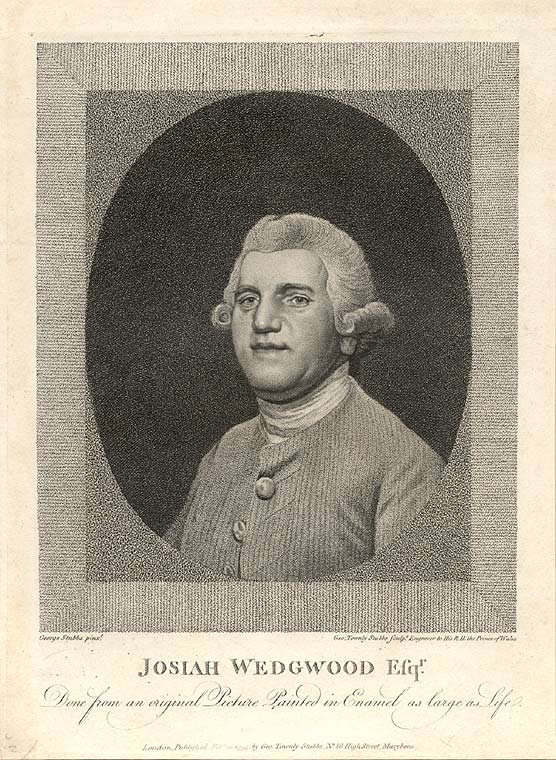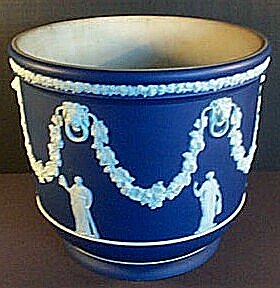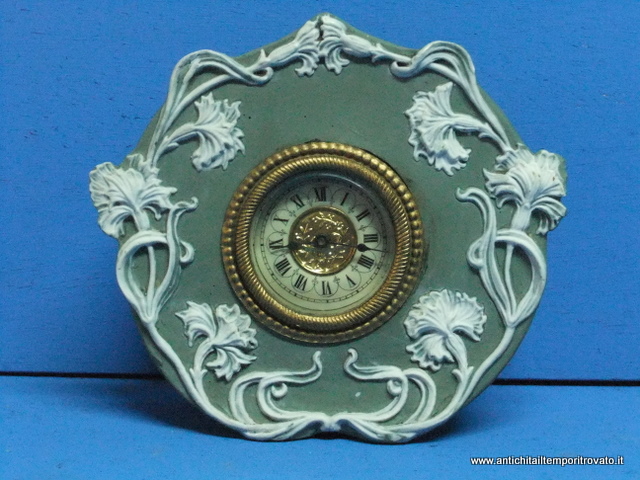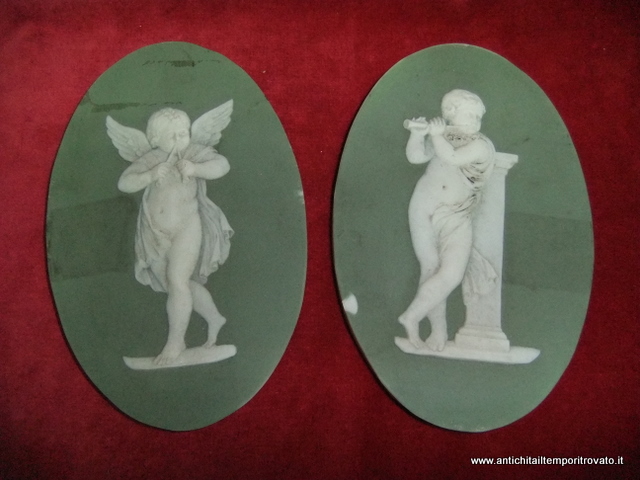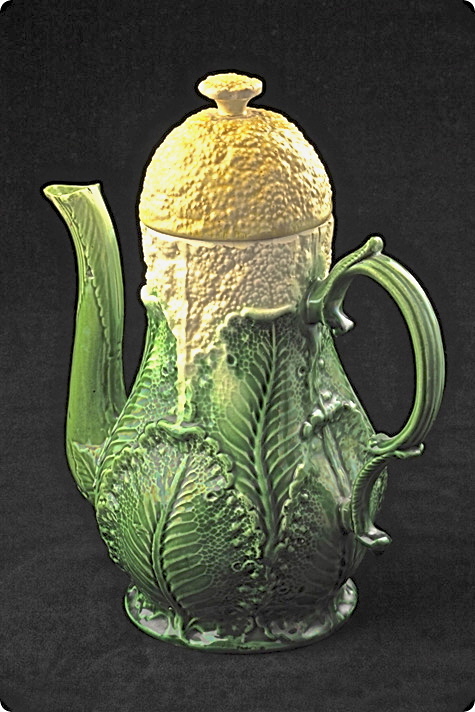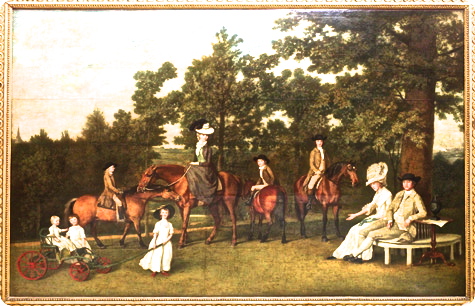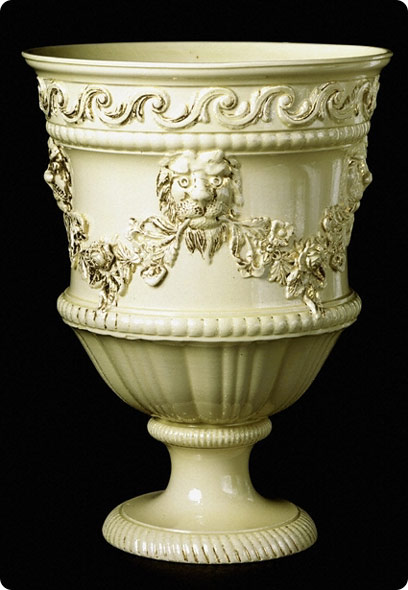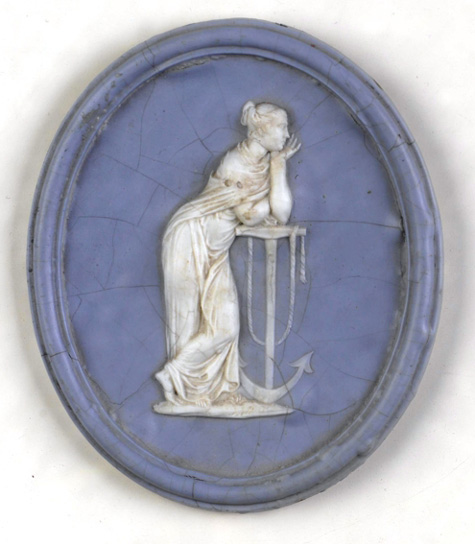A cura di "Antichità il tempo ritrovato" - Cagliari
Guida dell`antiquariato
Porcellane antiche
Wedgwood
Nel 1759 Josiah Wedgwood (1730-1795) nato a Burslem fondava a Stafford in Inghilterra un’immensa fabbrica di porcellana. Josiah impostò la sua produzione industriale su una moderna divisione del lavoro: il reparto design da un lato e quello di produzione dall`altro, tenendo i due nettamente distinti.
Furono fabbricati medaglioni, pendagli, fermagli e bottoni di pasta azzurra o nera con soggetti di fiori, figure o scene mitologiche in pasta bianca applicata su fondo scuro. Con le stesse figure furono realizzati vasi, coppe, tazze, ecc. Molte delle opere presero spunto da opere antiche egizie, greche o pompeiane (vedi le datazioni di Wedgwood).
Josiah era il 13° e ultimo figlio di Thomas Wedgwood (1687-1739) e di Mary Stringer (deceduta nel 1766), figlia del ministro unitariano di Newcaste under Lyme, una città della contea di Staffordshire (gli unitari erano un movimento religioso che rifiutava l`idea della trinità: metteva in dubbio l`essenza di Cristo e dello Spirito Santo in favore dell`unicità di Dio come persona).
La sua famiglia di origine era dedita alla realizzazione di ceramiche sin dal 600, ed il giovane Josiah iniziò a lavorare nell`industria di famiglia dopo la morte del padre.
Si hanno poche notizie dell`infanzia di Josiah: crebbe a Churchyard House, la casa che il padre Thomas aveva ereditato da suo padre, aveva sette anni quando frequentò la scuola a Newcastle under Lyme sino ai 14 anni (al 1744). Alla morte del padre la conduzione degli affari passò al fratello maggiore Thomas e nel 1744, lasciata la scuola, Josiah divenne apprendista presso l`azienda famigliare.
Josiah verso i 15/16 anni, nel 1745 o 1746, soffrì di un violento attacco di vaiolo che gli lasciò dei danni permanenti ad un ginocchio impedendogli di lavorare al tornio senza assistenza. Nonostante ciò proseguì il suo apprendistato contraddistinguendosi per la sua notevole abilità al tornio. Thomas era riluttante a cambiar sul lavoro o forse non era d`accordo nel dare una partecipazione nella società di famiglia a Josiah. Infatti dopo una prima breve società con John Harrison e Thomas Alders di Stoke-on-Trent (Staffordshire) all`età di 22 anni Josiah andò per conto suo. Nel 1952 dopo sette anni e un paio di società fù in grado di aprire un suo studio. Lavorò con il fratello fino al 1752, dopo una prima breve società con John Harrison e Thomas Alders di Stoke-on-Trent (Staffordshire).
Una delle società che formò giovanissimo (a soli 20 anni) fu quella con Thomas Whieldon di Fenton Low. Whieldon era un ceramista molto famoso e di grande successo: da lui Josiah apprese le tecniche più moderne su forme e colori. Fu presso di lui che migliorò la green glaze, una particolare tecnica di verniciatura in verde che è ancora in uso oggi e che rese famosi i suoi servizi a forma di cavolo (vedi foto a sinistra), decorati anche con decalcomanie.
Josiah si innamora di Sara, sua cugina (nota come Sally) e voleva sposarla. Ma ci fu un intoppo: Sally era molto ricca. Dopo alcune trattative con il padre di Sally, che non era inizialmente contento che la figlia volesse sposare un vasaio comune, la coppia si sposò nel 1764. Josiah aveva 34 e Sally 30. Non solo Sally portò con sè una dote considerevole, ma ha pure dimostrato di essere un esperta partner: dava importanti suggerimenti sulla progettazione e mentre Josiah conduceva i suoi esperimenti, lo aiutava prendendo nota. (vedi quadro a destra: Sally e Josiah son seduti nella panchina, attorniati dai loro sette figli).
Dopo un anno dal loro matrimonio, nel 1765, Wedgwood ha in produzione un particolare tipo di ceramica caratterizzata dal color crema (vedi vaso a sinistra). Fu invitato a presentare i suoi progetti davanti alla Regina Carlotta (Queen Charlotte). La sua ceramica, chiamata creamware cambia nome in Queen`s Ware in onore alla Regina Carlotta per la protezione accordata alla fabbrica.
In seguito cessò la collaborazione con Whieldon e si mise in proprio prendendo in affitto la Ivy House factory di Burslem ed assumendo alle proprie dipendenze il cugino, Thomas Wedgwood che nel 1765 divenne suo socio: il sodalizio durò fino al 1788. La pubblicità che ne deriva e le sue buone qualità la rendono la scelta preferita di tutta la ceramica domestica in Inghilterra e all`estero.Furono molte le manifatture che risentirono della concorrenza di Wedgwood, persino delle dimensioni e dell`importanza di quelle di Sèvres e Meissen. Quelle che sopravvissero iniziarono ad imitare la sua ceramica color crema, che sul continente venne detta Faenza Fine o Faenza Inglese.
Nel 1768 diventa socio del suo più caro amico: Bentley. Nel 1774 presero al loro servizio il 19enne John Flaxman come modellatore di fregi classici e nazionali, targhe, vasi ornamentali e ritratti nei medaglion. Flaxman diventerà un grande.
Per Josiah il periodo della società col suo amico Bentley fu uno dei più belli della sua vita, nonostante in quell`anno gli amputarono la gamba malata di vaiolo senza anestesia, tra l`anca e il ginocchio. Erano molto amici e si compensavano anche nel lavoro. Fu un brutto colpo per Josiah quando nel 1780 Bentley a solo 50 anni morì.Un ultima curiosità: Josiah Wedgwood nel 1782 inventò il pirometro, uno strumento per la misurazione delle alte temperature. Grazie alle sue scoperte divenne membro della Fellow della Royal Society, composta dagli scienziati più illustri del Regno Unito. Il pirometro di Josiah fu acquistato dal Museo di Fisica e Storia Naturale di Firenze tra il 1790 ed il 1817.
Information Antiquities CagliariIn 1759 Josiah Wedgwood (1730-1795) was born in Burslem based in Stafford in England immense porcelain factory. Incision-old Josiah Josiah Wedgwoodimpostò its industrial production of a modern division of labor: the design department on the one hand and the production on the other, taking the two clearly distinct.
They were manufactured medallions, pendants, brooches and buttons of pasta with blue or black subjects of flowers, figures or mythological scenes in white paste applied on a dark background. With the same figures were made vases, bowls, cups, etc.. Many of the works took inspiration from works of ancient Egyptian, Greek or Pompeian (see the dating of Wedgwood).
Josiah was the 13 th and last child of Thomas Wedgwood (1687-1739) and Mary Stringer (died in 1766), daughter of a Unitarian minister Newcaste under Lyme, a town in the county of Staffordshire (the Unitarians were a religious movement that rejected the idea of the trinity: questioned the essence of Christ and the Holy Spirit in favor of `oneness of God as a person).
While there is little news of childhood Josiah: grew up in Churchyard House, the house that Thomas`s father had inherited from his father, who was seven years old when he attended school in Newcastle under Lyme up to 14 years (to 1744).
Josiah to the 15/16 years, in 1745 or 1746, he suffered a severe attack of smallpox left him with permanent damage to his knee preventing him from working on the lathe without assistance. Despite this he continued his apprenticeship contraddistinguendosi for his considerable skill at the wheel.Thomas was reluctant to change at work or maybe it was not `d agree in giving a stake in the company of family Josiah. In fact, after a brief first company with John Harrison and Thomas Alders of Stoke-on-Trent (Staffordshire) at the age of 22 years Josiah went on his own. In 1952, after seven years and a couple of companies was able to open his own studio. He worked with his brother until 1752, after a brief first company with John Harrison and Thomas Alders of Stoke-on-Trent (Staffordshire).Whieldon was a very famous potter and successful: he Josiah learned the most modern techniques of shapes and colors. It was from him that improved the green glaze, a technique of painting in green, which is still in use today and that made her famous services in the form of cabbage (see photo at left), decorated with decals.
Josiah falls in love with Sara, her cousin (known as Sally) and wanted to marry her. After some negotiations with the father of Sally, who initially was not happy that his daughter would marry a potter`s town, the couple married in 1764. Josiah was 34 and Sally 30. Sally not only brought with him a considerable dowry, but has also proven to be an expert partners: gave important suggestions on the design and while Josiah conducted his experiments, helping him taking notes. (See picture to right: Sally and Josiah are sitting on the bench, surrounded by their seven children).
After a year of their marriage, in 1765, Wedgwood has produced a particular type of pottery characterized by cream-colored (see vase on the left). He was invited to present their projects in front of the Queen Charlotte (Queen Charlotte).
Following the partnership with Whieldon stopped and started his own business renting the Ivy House factory in Burslem and assuming employs his cousin, Thomas Wedgwood, which in 1765 became his partner: The partnership lasted until 1788. There were many manufacturers who resented the competition of Wedgwood, and even the size of the importance of those of Sevres and Meissen. Those who survived began to imitate his cream-colored pottery, and on the Continent was called Faenza Faenza Fine or English.
In 1768 he became a partner of his dearest friend, Bentley. In 1774 they took to their service, 19 year old John Flaxman as a shaper of national and classical friezes, plaques, ornamental vases and portraits in medaglion.
Flaxman will become a big one. For Josiah the period of the company with his friend Bentley was one of the most beautiful of his life, despite a year in that the bad leg amputated without anesthesia of smallpox, including the `hip and knee. They were close friends and were compensated in the work. Josiah was a blow to Bentley in 1780 when only 50 years died.A last question: Josiah Wedgwood in 1782 invented the pyrometer, an instrument for measuring high temperatures. Thanks to his discoveries became a member of Fellow of the Royal Society, composed of the most distinguished scientists of the United Kingdom. The pyrometer of Josiah was purchased by the Museum of Physics and Natural History in Florence between 1790 and 1817.
Furono fabbricati medaglioni, pendagli, fermagli e bottoni di pasta azzurra o nera con soggetti di fiori, figure o scene mitologiche in pasta bianca applicata su fondo scuro. Con le stesse figure furono realizzati vasi, coppe, tazze, ecc. Molte delle opere presero spunto da opere antiche egizie, greche o pompeiane (vedi le datazioni di Wedgwood).
Josiah era il 13° e ultimo figlio di Thomas Wedgwood (1687-1739) e di Mary Stringer (deceduta nel 1766), figlia del ministro unitariano di Newcaste under Lyme, una città della contea di Staffordshire (gli unitari erano un movimento religioso che rifiutava l`idea della trinità: metteva in dubbio l`essenza di Cristo e dello Spirito Santo in favore dell`unicità di Dio come persona).
La sua famiglia di origine era dedita alla realizzazione di ceramiche sin dal 600, ed il giovane Josiah iniziò a lavorare nell`industria di famiglia dopo la morte del padre.
Si hanno poche notizie dell`infanzia di Josiah: crebbe a Churchyard House, la casa che il padre Thomas aveva ereditato da suo padre, aveva sette anni quando frequentò la scuola a Newcastle under Lyme sino ai 14 anni (al 1744). Alla morte del padre la conduzione degli affari passò al fratello maggiore Thomas e nel 1744, lasciata la scuola, Josiah divenne apprendista presso l`azienda famigliare.
Josiah verso i 15/16 anni, nel 1745 o 1746, soffrì di un violento attacco di vaiolo che gli lasciò dei danni permanenti ad un ginocchio impedendogli di lavorare al tornio senza assistenza. Nonostante ciò proseguì il suo apprendistato contraddistinguendosi per la sua notevole abilità al tornio. Thomas era riluttante a cambiar sul lavoro o forse non era d`accordo nel dare una partecipazione nella società di famiglia a Josiah. Infatti dopo una prima breve società con John Harrison e Thomas Alders di Stoke-on-Trent (Staffordshire) all`età di 22 anni Josiah andò per conto suo. Nel 1952 dopo sette anni e un paio di società fù in grado di aprire un suo studio. Lavorò con il fratello fino al 1752, dopo una prima breve società con John Harrison e Thomas Alders di Stoke-on-Trent (Staffordshire).
Una delle società che formò giovanissimo (a soli 20 anni) fu quella con Thomas Whieldon di Fenton Low. Whieldon era un ceramista molto famoso e di grande successo: da lui Josiah apprese le tecniche più moderne su forme e colori. Fu presso di lui che migliorò la green glaze, una particolare tecnica di verniciatura in verde che è ancora in uso oggi e che rese famosi i suoi servizi a forma di cavolo (vedi foto a sinistra), decorati anche con decalcomanie.
Josiah si innamora di Sara, sua cugina (nota come Sally) e voleva sposarla. Ma ci fu un intoppo: Sally era molto ricca. Dopo alcune trattative con il padre di Sally, che non era inizialmente contento che la figlia volesse sposare un vasaio comune, la coppia si sposò nel 1764. Josiah aveva 34 e Sally 30. Non solo Sally portò con sè una dote considerevole, ma ha pure dimostrato di essere un esperta partner: dava importanti suggerimenti sulla progettazione e mentre Josiah conduceva i suoi esperimenti, lo aiutava prendendo nota. (vedi quadro a destra: Sally e Josiah son seduti nella panchina, attorniati dai loro sette figli).
Dopo un anno dal loro matrimonio, nel 1765, Wedgwood ha in produzione un particolare tipo di ceramica caratterizzata dal color crema (vedi vaso a sinistra). Fu invitato a presentare i suoi progetti davanti alla Regina Carlotta (Queen Charlotte). La sua ceramica, chiamata creamware cambia nome in Queen`s Ware in onore alla Regina Carlotta per la protezione accordata alla fabbrica.
In seguito cessò la collaborazione con Whieldon e si mise in proprio prendendo in affitto la Ivy House factory di Burslem ed assumendo alle proprie dipendenze il cugino, Thomas Wedgwood che nel 1765 divenne suo socio: il sodalizio durò fino al 1788. La pubblicità che ne deriva e le sue buone qualità la rendono la scelta preferita di tutta la ceramica domestica in Inghilterra e all`estero.Furono molte le manifatture che risentirono della concorrenza di Wedgwood, persino delle dimensioni e dell`importanza di quelle di Sèvres e Meissen. Quelle che sopravvissero iniziarono ad imitare la sua ceramica color crema, che sul continente venne detta Faenza Fine o Faenza Inglese.
Nel 1768 diventa socio del suo più caro amico: Bentley. Nel 1774 presero al loro servizio il 19enne John Flaxman come modellatore di fregi classici e nazionali, targhe, vasi ornamentali e ritratti nei medaglion. Flaxman diventerà un grande.
Per Josiah il periodo della società col suo amico Bentley fu uno dei più belli della sua vita, nonostante in quell`anno gli amputarono la gamba malata di vaiolo senza anestesia, tra l`anca e il ginocchio. Erano molto amici e si compensavano anche nel lavoro. Fu un brutto colpo per Josiah quando nel 1780 Bentley a solo 50 anni morì.Un ultima curiosità: Josiah Wedgwood nel 1782 inventò il pirometro, uno strumento per la misurazione delle alte temperature. Grazie alle sue scoperte divenne membro della Fellow della Royal Society, composta dagli scienziati più illustri del Regno Unito. Il pirometro di Josiah fu acquistato dal Museo di Fisica e Storia Naturale di Firenze tra il 1790 ed il 1817.
Information Antiquities CagliariIn 1759 Josiah Wedgwood (1730-1795) was born in Burslem based in Stafford in England immense porcelain factory. Incision-old Josiah Josiah Wedgwoodimpostò its industrial production of a modern division of labor: the design department on the one hand and the production on the other, taking the two clearly distinct.
They were manufactured medallions, pendants, brooches and buttons of pasta with blue or black subjects of flowers, figures or mythological scenes in white paste applied on a dark background. With the same figures were made vases, bowls, cups, etc.. Many of the works took inspiration from works of ancient Egyptian, Greek or Pompeian (see the dating of Wedgwood).
Josiah was the 13 th and last child of Thomas Wedgwood (1687-1739) and Mary Stringer (died in 1766), daughter of a Unitarian minister Newcaste under Lyme, a town in the county of Staffordshire (the Unitarians were a religious movement that rejected the idea of the trinity: questioned the essence of Christ and the Holy Spirit in favor of `oneness of God as a person).
While there is little news of childhood Josiah: grew up in Churchyard House, the house that Thomas`s father had inherited from his father, who was seven years old when he attended school in Newcastle under Lyme up to 14 years (to 1744).
Josiah to the 15/16 years, in 1745 or 1746, he suffered a severe attack of smallpox left him with permanent damage to his knee preventing him from working on the lathe without assistance. Despite this he continued his apprenticeship contraddistinguendosi for his considerable skill at the wheel.Thomas was reluctant to change at work or maybe it was not `d agree in giving a stake in the company of family Josiah. In fact, after a brief first company with John Harrison and Thomas Alders of Stoke-on-Trent (Staffordshire) at the age of 22 years Josiah went on his own. In 1952, after seven years and a couple of companies was able to open his own studio. He worked with his brother until 1752, after a brief first company with John Harrison and Thomas Alders of Stoke-on-Trent (Staffordshire).Whieldon was a very famous potter and successful: he Josiah learned the most modern techniques of shapes and colors. It was from him that improved the green glaze, a technique of painting in green, which is still in use today and that made her famous services in the form of cabbage (see photo at left), decorated with decals.
Josiah falls in love with Sara, her cousin (known as Sally) and wanted to marry her. After some negotiations with the father of Sally, who initially was not happy that his daughter would marry a potter`s town, the couple married in 1764. Josiah was 34 and Sally 30. Sally not only brought with him a considerable dowry, but has also proven to be an expert partners: gave important suggestions on the design and while Josiah conducted his experiments, helping him taking notes. (See picture to right: Sally and Josiah are sitting on the bench, surrounded by their seven children).
After a year of their marriage, in 1765, Wedgwood has produced a particular type of pottery characterized by cream-colored (see vase on the left). He was invited to present their projects in front of the Queen Charlotte (Queen Charlotte).
Following the partnership with Whieldon stopped and started his own business renting the Ivy House factory in Burslem and assuming employs his cousin, Thomas Wedgwood, which in 1765 became his partner: The partnership lasted until 1788. There were many manufacturers who resented the competition of Wedgwood, and even the size of the importance of those of Sevres and Meissen. Those who survived began to imitate his cream-colored pottery, and on the Continent was called Faenza Faenza Fine or English.
In 1768 he became a partner of his dearest friend, Bentley. In 1774 they took to their service, 19 year old John Flaxman as a shaper of national and classical friezes, plaques, ornamental vases and portraits in medaglion.
Flaxman will become a big one. For Josiah the period of the company with his friend Bentley was one of the most beautiful of his life, despite a year in that the bad leg amputated without anesthesia of smallpox, including the `hip and knee. They were close friends and were compensated in the work. Josiah was a blow to Bentley in 1780 when only 50 years died.A last question: Josiah Wedgwood in 1782 invented the pyrometer, an instrument for measuring high temperatures. Thanks to his discoveries became a member of Fellow of the Royal Society, composed of the most distinguished scientists of the United Kingdom. The pyrometer of Josiah was purchased by the Museum of Physics and Natural History in Florence between 1790 and 1817.
